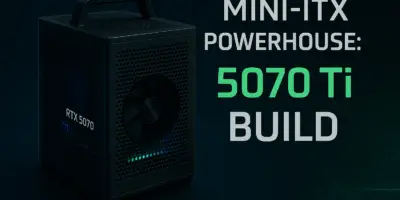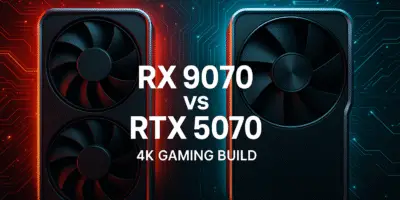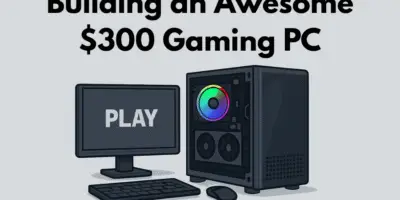Hey there, fellow tech enthusiasts! Whether you’ve got a shoestring budget or money to burn, I’m going to walk you through choosing the perfect PC components that’ll give you maximum bang for your buck. I promise—if you follow all the steps I’m about to share, you’ll avoid getting ripped off and know exactly what performance to expect before you even purchase anything.
Table of Contents
The Super Budget Build ($200-$250)
When you’re working with around $200-$250, our primary goal is performance—not upgradability or aesthetics. At this price point, performance is king.
From my years of experience in the market, the fastest and easiest way to get excellent performance at this price is simple: buy a pre-built system. Just head to your local PC shop or order online a system with these specs:
- CPU: Core i5 4th gen or equivalent/better (Core i7 4th gen, Core i5 5th/6th/7th/8th gen)
- Form Factor: Make sure it’s a standard tower that can fit an external graphics card (some small form-factor systems won’t accommodate one)
After buying the system, you’ll need a graphics card. The options depend on the power supply in your pre-built PC:
- If it has a 200W, 180W, or 250W power supply: GTX 1050 Ti or GTX 1650
- If it has a 350W+ power supply: You might be able to install a GTX 1650 Super with a SATA to 6-pin power adapter
Remember though—don’t go overboard with a powerful card like an RTX 2080 even if your power supply can handle it. Your CPU will likely bottleneck it anyway.
Your final system should look something like this:
- Core i5 4th gen or better
- GTX 1050 Ti or GTX 1650
- 16GB RAM
- SSD for your operating system (super important!)
Look, I want to emphasize something important: This system isn’t bad! If you’re choosing between no PC at all or a system like this with a graphics card, definitely go with this option. It’s better than nothing, trust me.
I personally used a system with a Core i7 3770 (3rd gen), 16GB RAM, 256GB SSD, 500GB HDD, and a GTX 1050 Ti for years. I played literally every game I wanted to play on that system, did video editing, programming—it handled everything just fine. So don’t buy into the shame some people try to push about “outdated” systems.
How to Know What Performance You’ll Get
This is actually pretty simple! Just go on YouTube and search for your CPU model + GPU model (e.g., “i5 4th gen GTX 1050 Ti”) and you’ll find dozens of videos of people testing these exact specs with modern and older games. This way, you’ll know exactly what to expect before spending a dime.
The Mid-Range Build ($300-$400)
With $300-$400, your options start to open up. In my opinion, the best platform for this budget is AM4 (AMD Ryzen from 1st to 5th gen).
Here’s what I’d recommend:
- Motherboard: B450, B550, or even B350 (though B350 boards might need a BIOS update)
- CPU: Any Ryzen 5 or Ryzen 7 will serve you well—options like Ryzen 5 2600, Ryzen 7 5700X, Ryzen 7 2700, Ryzen 5 5600, Ryzen 5 4500, Ryzen 5 3600, or Ryzen 7 3700
Quick tip: Avoid CPUs with the “G” suffix as they prioritize integrated graphics over CPU performance. Since we’re adding a discrete graphics card anyway, we don’t need that trade-off.
- RAM: 16GB (aim for 3200MHz or faster)
- Storage: Definitely get an SSD—seriously, they’re super cheap now (around $15 for 256GB) and make a world of difference
- Power Supply: Any quality 500W+ unit should work fine (but do check reviews before buying!)
If you can’t find Ryzen CPUs, my second recommendation would be 12th gen Intel:
- Motherboard: H610, B760, or B660
- CPU: i5-12400F, i5-13400F, i3-12100F, or i3-13100F
For the graphics card, you’ve got plenty of options at this price range. My favorites are:
- GTX 1660 Super
- GTX 1660 Ti
- RTX 2060 Super (not the standard version)
- RTX 2070
- RX 5700 XT
I’d suggest avoiding the 10-series cards like the 1060, 1070, or 1080. While they still perform well, NVIDIA will likely stop driver support for them soon, meaning their performance in future games will suffer.
The Upper Mid-Range Build ($500-$700)
At this price point, you’ve got a choice to make: maximum performance now or better future upgradability?
If you want the best performance right now without worrying about the future, go with any Ryzen 5500/5600/5700X/5700 paired with the strongest GPU you can afford—maybe an RTX 3070, 3080, 3090, 4070, 3060, 2080, RX 6600, RX 6700, or RX 7800. A B550 motherboard would be excellent here, with prices currently quite reasonable.
But if you prefer upgradeability over immediate performance (which is honestly my recommendation), here’s a better strategy: Get a newer platform with a weaker GPU temporarily, then upgrade the GPU later.
For example, get a B650 motherboard with a Ryzen 7 7600. This is a modern platform that will likely last you many years. Yes, you’ll have less performance initially with a weaker GPU (maybe a GTX 1650 to start), but you’ll have a stronger CPU and newer platform. Later, you can sell the GPU and upgrade to something more powerful.
RAM-wise, 16GB is still fine, but if you go with a DDR5-only platform, you might end up needing to buy 32GB since 16GB DDR5 kits are harder to find.
The High-End Build ($900-$1300+)
At this price point, it’s absolutely essential to get a modern platform—either Intel or AMD. Personally, I think AMD’s AM5 platform is fantastic.
Consider something like:
- Motherboard: B650 or B750
- CPU: Ryzen 5 7600 or Ryzen 7 7800X
- RAM: 32GB DDR5 (ideally around 6000MHz)
- Power Supply: 800W+ (I’d strongly recommend going for 1000W if you can afford it—it’ll last you through multiple upgrades)
For the graphics card, I’d actually recommend waiting for AMD’s new RX 9070 and RX 9070 XT, as they offer incredible value for money and have all the technologies you’d need for gaming or content creation.
If you can’t wait, some excellent current options are:
- RTX 4070 Super
- RX 7800 XT
- RTX 4070 Ti Super
- RTX 4080 (if your budget allows)
As for the case, my personal favorites right now are the Hyte Y70 and Hyte Y60. They look incredible, and if you have extra cash to splurge, the Hyte Y70 Touch with its display panel is absolutely phenomenal. Hyte cases can be hard to find in some regions, but they’re worth the effort in my opinion.
Final Thoughts
Remember these key points:
- Always check performance before buying by looking up YouTube videos of your specific CPU+GPU combination running games
- An SSD is non-negotiable for your operating system—HDDs will make your system painfully slow
- Don’t be ashamed of budget builds—they can still play tons of games and handle productivity tasks just fine
- Consider future upgradability when making your choices, especially at mid to high budgets
I hope this guide helps you make the best choice for your budget! What build are you leaning toward? Have any questions about specific components? Let me know in the comments!



